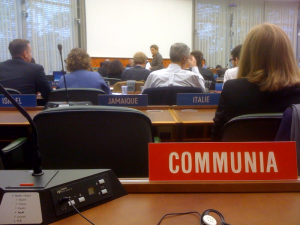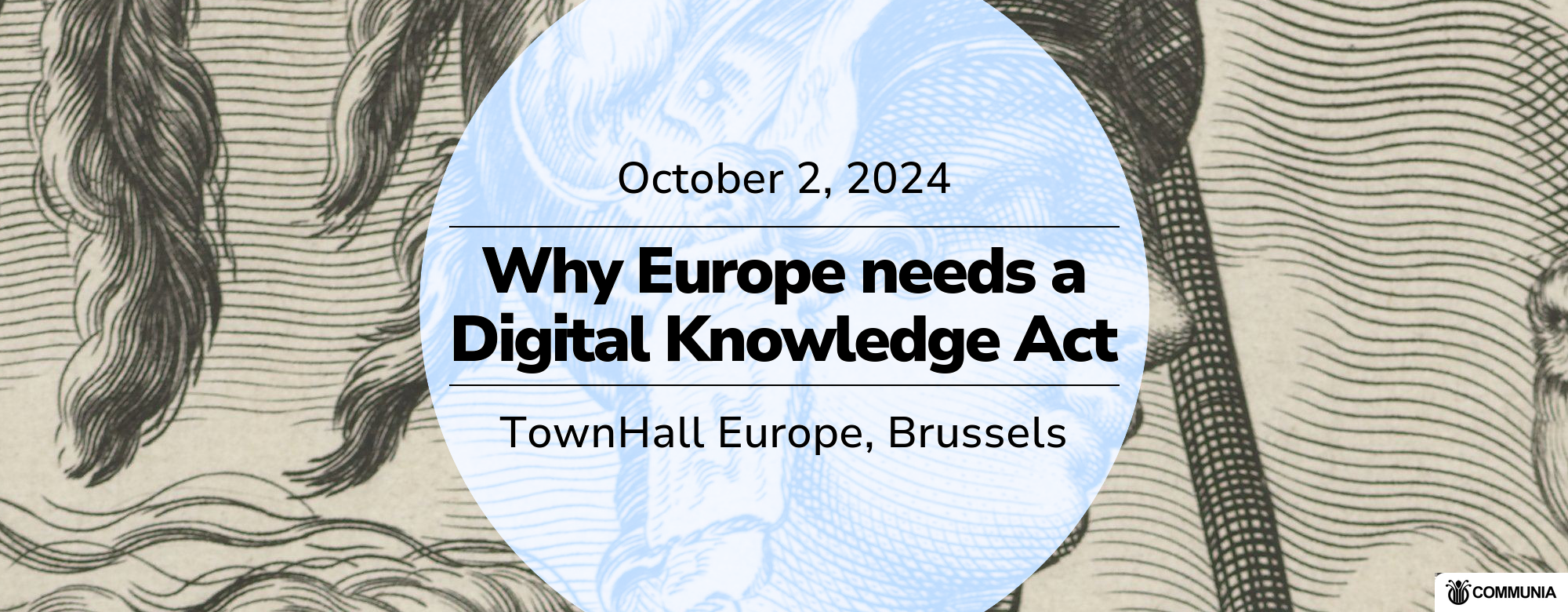This CDIP/10 second statement on Scenarios and Possible Options Concerning Recommendations 1c, 1f and 2a of the Scoping Study on Copyright and Related Rights and the Public Domain (CDIP/9/INF/2 Rev.) is following Communia’s previous statements delivered at:
– CDIP/10 commenting on Terms of Reference for a Comparative Study on Copyright Relinquishment (document CDIP/10/14),
– CDIP/9 on the Scenarios and Possible Options Concerning Recommendations 1c, 1f and 2a of the Scoping Study on Copyright and Related Rights and the Public Domain by the Secretariat (document CDIP/9/INF/2) and
– CDIP/8 supporting the Scoping Study on Copyright and Related Rights and the Public Domain by Séverine Dusollier (document CDIP/7/INF/2).

Comments on the Scenarios and Possible Options Concerning Recommendations 1c, 1f and 2a of the Scoping Study on Copyright and Related Rights and the Public Domain
COMMUNIA International International Association on the Public Domain welcomes the document prepared by the WIPO Secretariat for the tenth session of the Committee on Development and Intellectual Property (CDIP) entitled Scenarios and Possible Options Concerning Recommendations 1c, 1f and 2a of the Scoping Study on Copyright and Related Rights and the Public Domain (CDIP/9/INF/2 Rev.).
COMMUNIA would like to submit proposals to allow CDIP to build upon the reflection suggested by the Scoping Study on the Public Domain drafted by Professor Dusollier (CDIP/7/INF/2. Hereafter: the Study).
First, COMMUNIA suggests that the Committee expand its consideration to other recommendations from the Study, as all of them are extremely valuable and need to be further examined, especially:
– Recommendation 1.e on “orphan works”;
– Recommendation 2.b encouraging legal deposit;
– Recommendation 2.c on the role of libraries.
These recommendations are complementary to recommendation 1f of the Study aiming at identifying what should belong to the Public Domain.
Second, COMMUNIA urges WIPO delegations to select concrete actions that could be developed by CDIP to provide assistance to Member States. On the basis of the recommendations proposed by the Scoping Study, we have the following comments:
– On recommendation 1f on the development of technical or informational tools to identify the contents of the Public Domain:
Registration tools that enable the identification and location of rights holders are of crucial importance in the context of mass digitization and use of cultural resources, as shown shown by the “orphan works” phenomenon. The development and promotion of these tools need to be encouraged. WIPO has already started to investigate the need for these mechanisms, as demonstrated by the Survey of Private Copyright Documentation Systems and Practices, coordinated by the NEXA Research Centre (available at http://www.wipo.int/meetings/en/2011/wipo_cr_doc_ge_11/pdf/survey_private_crdocystems.pdf)). The development of such works and rights registries under the auspices of WIPO (similar to the ongoing Global Repertoire Database initiative for musical works) should be further considered. How these registries shall be governed under a comprehensive policy providing for a balance between private and public interests – and how they could be put in place within the Berne Convention framework – require ongoing dedicated discussions. These discussions should also address the role of collecting societies in the administration of common information technology infrastructures allowing such databases to be effective on a trans-national level.
Useful Public Domain legal tools can leverage metadata to help promote the discovery and identification of materials in the Public Domain. For instance, the Creative Commons’ CC0 Public Domain Dedication license and the Public Domain Mark allow identifying works with machine-readable metadata of copyright licensing terms and related information, so that content can be exposed to Internet search engines. By leveraging this metadata, search engines can discern and communicate to end users what is available for reuse, and under which conditions.
– On recommendation 2a and the role of cultural heritage institutions:
Following the input from the UNESCO International Conference on Memory of the World in the Digital Age: Digitization and Preservation, which took place in September 2012 in Vancouver, COMMUNIA suggests that CDIP develop guidelines for memory institutions that curate works already in the Public Domain in order to help them to release digital reproductions of Public Domain works (as well as related notices and metadata they are producing to accompany these works). Oftentimes, museums and libraries add contractual restrictions (terms of use) to access and use of Public Domain works they host on their websites. These practices should end. According to COMMUNIA policy recommendation #5, “Digital reproductions of works that are in the Public Domain must also belong to the Public Domain. The use of works in the public domain should not be limited by any means, either legal or technical.”
Third, COMMUNIA proposes to bring substantive legal proposals from the Scoping Study to SCCR negotiations for the definition of a Public Domain positive agenda. Having a clear definition of the Public Domain in an international legal instrument and outlining the legal means to prevent the re-enclosure of works in the Public Domain should be considered as agenda items in future SCCR discussions.
In this purpose, COMMUNIA has several recommendations:
1. Defining a positive status for the Public Domain
The Public Domain deserves a positive recognition to better identify works and uses which are available for creators and users to build upon. It is time for copyright policymakers to consider the Public Domain as something more than a mere “non IP protected” zone. Such an evolution in describing the Public Domain would be consistent with the history of “Intellectual Property”, which used to consider the Public Domain as the rule and copyright as the exception, as a temporary and limited monopoly of exploitation.
This positive status shall be reached by:
1.1. Integrating a definition of the Public Domain within copyright law instruments.
1.2. Preserving the Public Domain from private appropriation.
Beyond a positive definition, the Public Domain should be preserved from private appropriation and closures through legal, contractual or technical barriers. Works that are in the Public Domain in analogue form should stay in the Public Domain once they have been digitized.
2. Recognizing the validity of voluntary dedication to the Public Domain
Dedicating a work to the Public Domain should be considered as a legitimate way to exercise one’s exclusive right and as compatible with moral rights. The legal enforceability of voluntary dedications should be evenly recognized in all jurisdictions.
3. Facilitating the identification of the contents of the Public Domain
It is difficult to assess whether a work is in the Public Domain, notably because of the complexity and the lack of harmonized copyright rules pertaining to the duration of protection. There is a need for certainty for users to clearly identify what is in the Public Domain. Beyond registration and Rights Management Information tools, legal security is required in order to assess the status of a work or any subject-matter eligible for copyright or copyright-related protection.
This shall be implemented through:
3.1. Simplified and harmonized copyright duration and territoriality rules
Establishing a harmonized framework with regard to copyright scope and duration would permit an easier identification of Public Domain works across the world.
3.2. Rights Information Measures
The role of Rights Management Information (RMI) should be recognized in the identification of the contents of the Public Domain.
3.3. Registration tools
The relevance of registration tools to help identify and locate rights holders and Public Domain contents has to be acknowledged and further analyzed.
